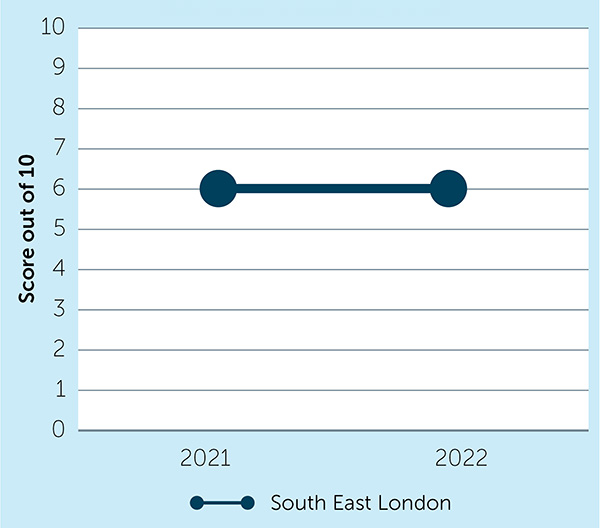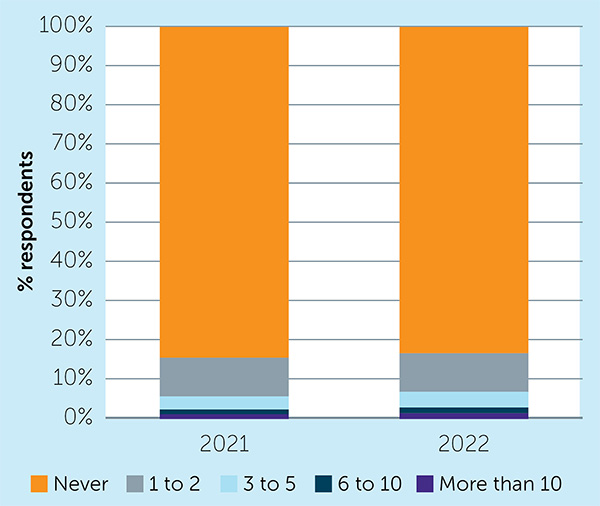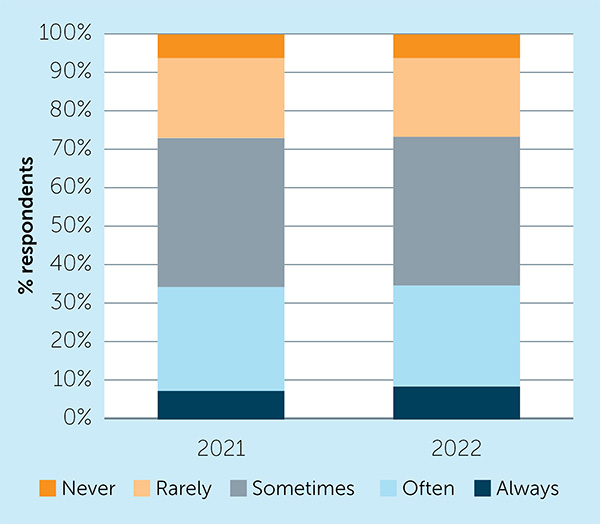NHS Staff survey data
We are safe and healthy - score

The score for SEL for the ‘We are safe and healthy’ People Promise theme has remained consistent at around 5.9. This is roughly in line with other London ICSs.
Q13a – In the last 12 months how many times have you personally experienced physical violence at work from patients / service users, their relatives or other members of the public?

15% of staff have experienced physical violence at work from service users, their relatives or other members of the public. This has increased slightly from 14.5% in 2021.
Q12b – How often, if at all do you feel burnt out because of work?

More than a third of staff feel burnt out because of work always or often, while only 7% never experience it. There was 1% increase in those who responded ‘Always’ from 2021.
South East London Primary and Social care health and wellbeing survey
Q12: How good is existing support from your employer in regards to your personal health and wellbeing?

The results suggest an inconsistent offer for personal health and wellbeing for primary and social care staff.
Qualitative feedback highlighted wider influencing factors on personal health and wellbeing. Workload was cited as key issue that impacts all aspects of wellbeing. Speed of access to support and specifically menopause support were also highlighted as key issues.
Feedback:
- “The problem in primary is workload. This is what impacts all of our well being. We simply don’t have time to focus on well being due to the demands being put on us”
- “The primary response to wellbeing is offering support to manage work related stress rather than tackling root cause”
- “Provide fast track access to talking therapies/ musculoskeletal services etc. for NHS/ Social Care workers”
- Managers should be more aware, knowledgeable, and understanding of the perimenopause, menopause and its effect on women. Empathy and compassion.”
Stakeholder interviews
The key themes from engagement with members of SHWB Committee are summarised below:
| Key themes | Overview |
|---|---|
| Strategy format and scope | The new strategy should be:
|
| Data and evaluation | Key focus on data and feedback from staff, such as surveys, audits and co-design. This should also include ways to monitor and evaluate the impact of interventions and to communicate the results to staff and leaders. |
| Levelling up and collaboration | Promote sharing and collaboration across organisations and sectors, such as sharing resources, expertise, tools, and best practices. Levelling up of primary care and social care remains important.Think global, act local: Design sustainable interventions (in the context of no sustainable funding), that can be easily tailored locally. |
| Accessibility and equity | The strategy should be accessible and meaningful to all staff, regardless of their background, preferences, or needs. It should also ensure equity of access and opportunity for staff across the system, especially for those who are most impacted by the removal of Keeping Well SEL. Awareness of the language used and a focus on cultural sensitivity are also key. |
| Community and engagement | Aim to create a sense of community and engagement among staff, as this can help to reduce isolation, break down silos, and foster a positive culture. Important to focus on communicating and interacting with staff, through events and initiatives such as such as wellbeing fairs, recognition events, theatre forums etc. |
| Clear governance | Important to assess the relationship between the Staff Health and Wellbeing Committee and the People Board. The former to play advisory role to the People Board on SHWB matters. |
| Priority areas | Violence, abuse and aggression (VAA): This is a major issue affecting staff wellbeing, especially from service users. The strategy should address how to prevent, reduce, and respond to VAA, and how to support staff who experience it. It should also link VAA to trauma informed care and share learning across the system.
Mental health/addressing burnout: Focusing on mental health and addressing post-pandemic burnout are key priorities. |
Other London ICSs
Review of Keeping Well websites has shown what other London ICSs are focusing on these top priorities:
- Financial wellbeing: debt management, pensions etc.
- Mental and emotional wellbeing: stress, anxiety, depression, sleep management, bereavement
- Physical wellbeing: long Covid, nutrition, weight management etc.
- Targeted offers: women’s health (menopause a key priority), men’s health (increase in referrals)
* Offers include a mixture of self-care guides, webinars, access to apps and training for managers on wellbeing.
Summary
Key priorities emerging from the stakeholders interviews and desktop research:
Read the sections of the strategy below
